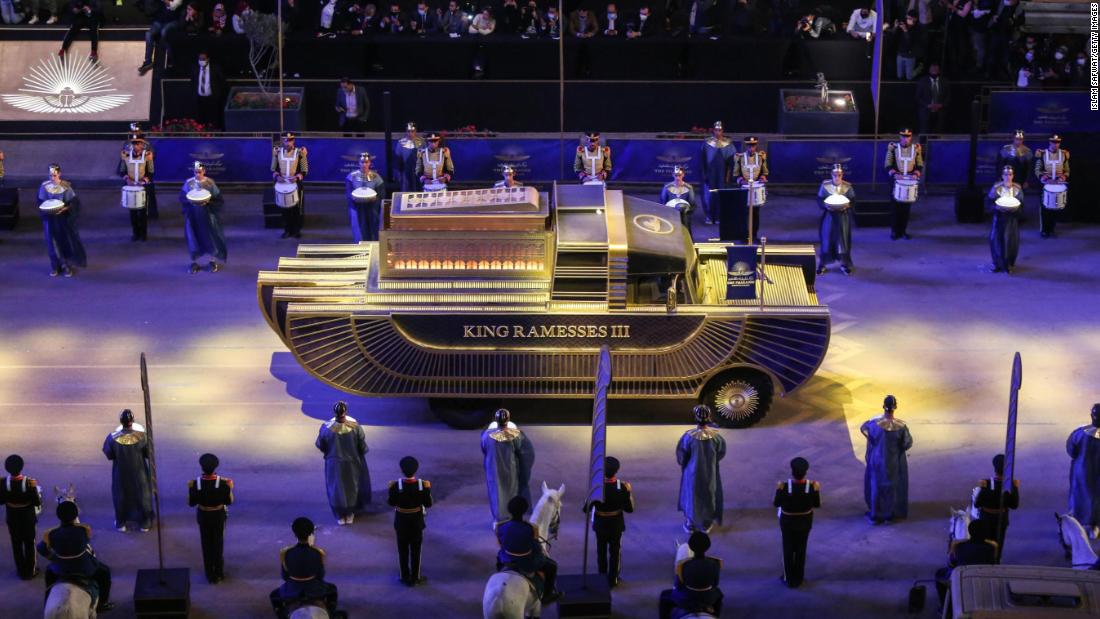
(CNN) – Ancient mummies of Egypt’s royal pharaohs emerged from their resting places Saturday and were paraded through the streets of Cairo to a new home.
What sounds like the plot of a movie was part of a lavish celebration of Egypt’s history and a project to move some of its greatest treasures into a new high-tech facility.
The mummies of Ramesses the Great and 21 others were part of “The Pharaoh’s Golden Parade”, a highly anticipated event organized by the Egyptian Ministry of Tourism and Antiquities.
The parade route took place between the Egyptian Museum, their old location near Tahrir Square, to their new home, the National Museum of Egyptian Civilization (NMEC) in Egypt’s first Muslim capital, al-Fustat.
“I invite all Egyptians and the whole world to follow this unparalleled event – which evokes the spirit of the great ancestors who preserved the homeland and created a civilization in which all humanity is proud – to continue on our path that we have begun: the path of construction and humanity. “

The carriages with 22 ancient Egyptian royal mummies depart from the Egyptian Museum in Cairo’s Tahrir Square during the parade.
Khaled Desouki / AFP / Getty Images
Sarcophagi are stone coffins often decorated with sculptures and inscriptions.
Among the mummies are those of Kings Ramses II, Seti I, Seqenenre, and Tuthmosis III, along with four queens: Ahmose-Nefertari, Tiye, Meritamun, and Hatshepsut.
The parade was greeted by 21 gun salutes and was accompanied by a military band. The mummies were transported on specially decorated vehicles with their names engraved in ancient Egyptian hieroglyphs and in Arabic.
The mummies that took part in the parade were discovered in two cachettes. The first was excavated in 1881 at Deir El-Bahari in Luxor’s West Bank in tomb TT320.
All 22 royal mummies come from the New Kingdom, an era when underground tombs were built with hidden entrances to ward off grave robbers.
Preparing the mummies
The purpose of the parade was to retrieve the 18 Kings and Four Queens of Egypt, along with their coffins and belongings, from their old home in the Egyptian Museum.

Performers dressed in ancient Egyptian costume march at the start of the parade of 22 ancient Egyptian royal mummies departing from the Egyptian Museum in Cairo’s Tahrir Square.
Mahmoud Khaled / AFP / Getty Images
Dr. Mostafa Ismail, head of conservation at the Mummies Conservation Lab and Storeroom at the NMEC, led a team of 48 people to prepare the royal mummies.
The preservation process, he told CNN, involves placing each mummy in an oxygen-free nitrogen capsule “that can keep it preserved without being damaged by the effects of humidity, especially bacteria, fungi and insects.”
The capsule is surrounded by a soft material that distributes the pressure and reduces vibrations during transport.
When the mummies arrive at the NMEC, the display units will have exactly the same conditions as the nitrogen capsules. “So there won’t be any shock to the mummy if we take it out of the box and put it in these units,” adds Ismail.
Each mummy is accompanied by all the belongings discovered next to them, including their coffins.
Displays also show CT scans showing what’s under wraps, and sometimes any broken bones or illnesses that have affected the royals.
CNN’s Taylor Barnes and Hamdi Alkhshali contributed to this report.